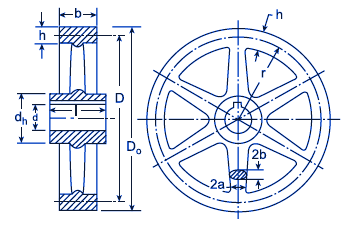Flywheel Effect or Polar Moment of Inertia
Mechanics and Machines Calculations Menu
The flywheel effect, sometimes also referred to as "Mass Momentum", is a term used to describe the property of a system to remain at a given velocity or kinetic energy. It is generally applied to rotating mass, such as flywheels or clutch plates.
The following equations and calculator will estimate the Flywheel Effect or Polar Moment of Inertia.

| Description | Equation |
|---|---|
| Flywheel Effect or Polar Moment of Inertia | |
| Mean Angular Velocity | |
| Coefficient of Steadiness |
Where:
| Symbol | Description | Units |
|---|---|---|
| Wk2 | Flywheel Effect or Polar Moment of Inertia |
kN (lbf) |
| W | Weight of Flywheel | N (lbs) |
| E | Excess energy | J (ft-lbf) |
| g | Acceleration due to gravity | 9.8 m/s2 (32.16 ft/s2) |
| n1 | Maximum speed | rpm |
| n2 | Minimum speed | rpm |
| Average speed | rad/s | |
| Maximum and minimum angular speed, respectively |
rad/s | |
| m | Coefficient of Steadiness | - |
| Cf | Coefficient of Fluctuation of Rotation |
See Table |
| Coefficient of Fluctuation of Rotation Table, Cf | ||
|---|---|---|
| Driven machine | Type of drive | Cf |
| AC generators, single or parallel | Direct-coupled | 0.01 |
| AC generators, single or parallel | Belt | 0.0167 |
| DC generators, single or parallel | Direct-coupled | 0.0143 |
| DC generators, single or parallel | Belt | 0.029 |
| Spinning machinery | Belt | 0.02–0.015 |
| Compressor, pumps | Gears | 0.02 |
| Paper, textiles, and flour mills | Belt | 0.025–0.02 |
| Woodworking and metalworking machinery | Belt | 0.0333 |
| Shears and pumps | Flexible coupling | 0.05–0.04 |
| Concrete mixers, excavators, and compressors | Belt | 0.143–0.1 |
| Crushers, hammers, and punch presses | Belt | 0.2 |